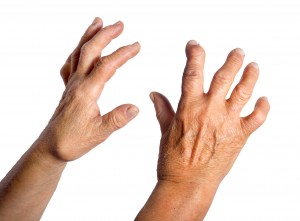

 Rheumatoid arthritis and skin complication symptoms range from mild to severe, causing lesions. Although rheumatoid arthritis commonly affects the joints, it can also involve organs and the skin, too. Many rheumatoid arthritis patients will experience skin manifestations and symptoms can vary greatly. On the severe side, skin complications can even result in lesions.
Rheumatoid arthritis and skin complication symptoms range from mild to severe, causing lesions. Although rheumatoid arthritis commonly affects the joints, it can also involve organs and the skin, too. Many rheumatoid arthritis patients will experience skin manifestations and symptoms can vary greatly. On the severe side, skin complications can even result in lesions.
Roughly 10 to 40 percent of patients will develop nodules, which consist of infiltrating inflammatory cells that surround the nexus of necrosis. Nodules can vary in size and are commonly found on the extensor surfaces. Nodules are quite common in rheumatoid arthritis, but some factors may increase a person’s risk of developing them, such as testing positive for rheumatoid factor and smoking. Majority of nodules are asymptomatic, meaning, they do not require treatment, but for nodules that interfere with physical function, injections or surgical removal may be required.
Lower-extremity ulcers are less frequent than nodules and occur in up to nine percent of patients, but rates are decreasing thanks to advancements in therapy. Ulcers that do develop in rheumatoid arthritis patients may be persistent and chronic, and many of them do not heal well even with proper treatment. Factors that contribute to ulcers in rheumatoid arthritis include poor blood supply, repeated pressure or trauma to the affected areas, and rheumatoid vasculitis.
Rheumatoid vasculitis is a serious condition but quite uncommon, with a rate of 0.1 to five percent. It usually occurs 10 to 15 years after disease diagnosis, and is seen in small to medium blood vessels. Symptoms include nail infarcts, nail bed papules, purple spots, rashes, and bruises. More serious complications of rheumatoid vasculitis include ulcers, necrotic lesions, and gangrene.
Aside from this more common skin conditions, there are others that can affect rheumatoid arthritis patients, including pyoderma gangrenosum, Sweet’s syndrome, rheumatoid neutrophilic dermatosis (RND), subcorneal pustular dermatosis, and palisaded neutrophilic granulomatous dermatitis. These involve inflammatory lesions characterized by massive infiltration of neutrophils in the absence of infection. Lesions can range from asymptomatic and resolving on their own to eruptions of pain and fever.
There are medications to specifically treat skin complications in rheumatoid arthritis, such as methotrexate, non-biologic DMARDs (disease-modifying anti-rheumatic drugs) and tumor necrosis factor-α (TNF) inhibitors. Unfortunately, although these medications may treat skin complications, they also bring along side effects and other complications. For starters, the use of TNF inhibitors may be associated with the development of psoriasis, along with effects to the injection site, infusion reactions, skin infections, eczema, lupus, vasculitis, lichenoid drug eruptions, and granulomatous reactions.
Rheumatoid arthritis patients are also at a higher risk for skin cancer and TNF inhibitors may increase this risk further, but research is still pending on a definite conclusion.
Other side effects of medications include skin rashes, easy bruising, and sun sensitivity. Speak to your doctor about any side effects you may experiencing while taking medications for rheumatoid arthritis.
Rheumatoid arthritis risk increases with repetitive physical workload: Study
Rheumatoid arthritis (RA) risk increases with repetitive physical workload, according to research. Previously, prolonged work-related physical activity has been linked to osteoarthritis in some joints. Continue reading…
Rheumatoid arthritis patients face higher gout risk today than in the past: Study
Rheumatoid arthritis patients face higher gout risk today than in the past, according to research. Gout is a type of arthritis characterized by crystals forming in small joints as a result of excess uric acid in the bloodstream, whereas rheumatoid arthritis is an autoimmune disease. Continue reading…
Sources:
http://www.medpagetoday.com/resource-center/Advances-in-RA-Management/Skin-Deep/a/56043
http://www.webmd.com/rheumatoid-arthritis/guide/rheumatoid-arthritis-skin-problems
Copyright © www.orthopaedics.win Bone Health All Rights Reserved